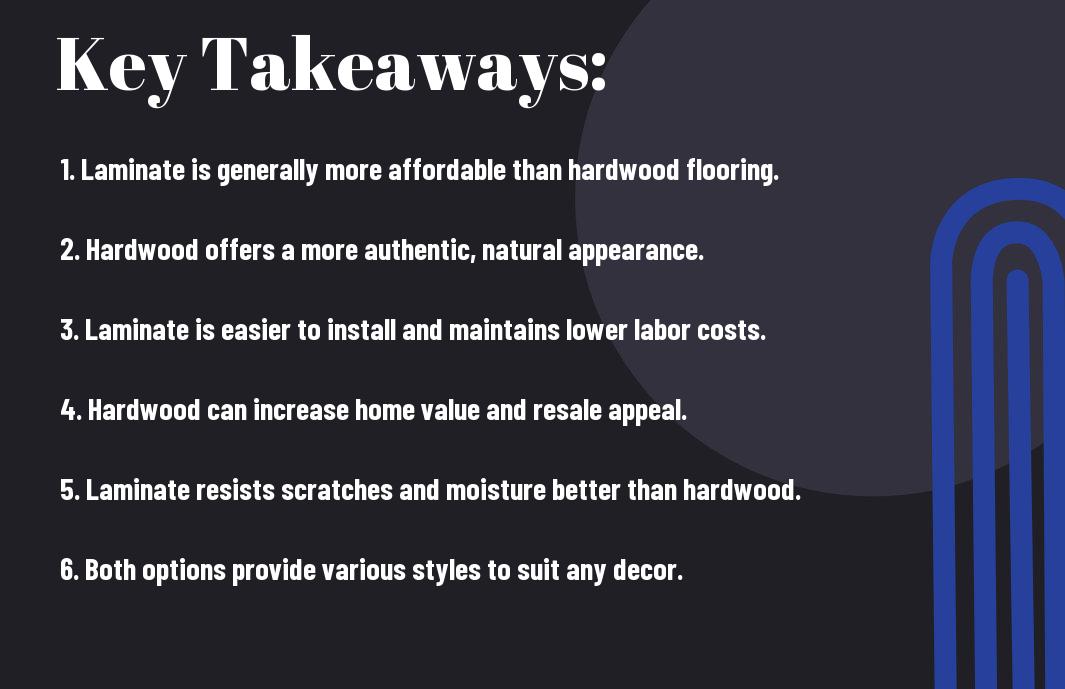You want to make an informed decision about flooring, and understanding the differences between laminate and hardwood is important. Both options offer distinct advantages, but your choice will significantly impact your budget and long-term satisfaction. In this post, we’ll explore the cost-effectiveness of each type, examining factors like installation, maintenance, and overall durability. By the end, you’ll be equipped to choose the flooring solution that best aligns with your needs and lifestyle.

Overview of Flooring Options
As you explore flooring options, you’ll quickly find that choosing the right material is important for both aesthetics and functionality. Laminate and hardwood flooring are two popular choices, each offering unique benefits and drawbacks. Understanding the differences between these types will help you make an informed decision based on your preferences, lifestyle, and budget.
Definition of Laminate Flooring
At its core, laminate flooring is a synthetic product designed to imitate the appearance of natural wood or stone. Composed of several layers, it combines a high-resolution image layer with a protective finish, providing durability and ease of maintenance. This option is ideal for budget-conscious homeowners who still want an attractive flooring solution.
Definition of Hardwood Flooring
Behind the timeless beauty of hardwood flooring lies a premium product crafted from natural wood. This flooring is made of solid or engineered wood planks, offering warmth and an authentic aesthetic that can enhance the value of your home. While it tends to come at a higher price point, many homeowners appreciate its longevity and unique grain patterns.
Flooring made from hardwood can last for decades when properly maintained, featuring a variety of species, stains, and finishes that can fit any design scheme. Its natural beauty provides a distinct character that cannot be replicated, making it a sought-after option for those looking to invest in high-quality materials. You can even refinish hardwood floors multiple times over their lifespan, allowing you to adapt their look to changing styles without the need for replacement.
Cost Comparison
Now, let’s break down the costs associated with laminate and hardwood flooring to give you a clearer picture of your investment.
Cost Breakdown
| Flooring Type | Average Cost (per square foot) |
|---|---|
| Laminate | $1 – $5 |
| Hardwood | $5 – $15+ |
Initial Costs
At the outset, the initial costs of laminate flooring are significantly lower than those of hardwood. Laminate can be installed for a few dollars per square foot, making it a budget-friendly option for homeowners. In contrast, hardwood flooring may start at five times the price, which can add up quickly, depending on your space.
Long-term Expenses
Initial costs are just one aspect of the flooring equation; you must also consider long-term expenses over the lifespan of your choice. While laminate is less expensive upfront, hardwood can retain its value better and may even appreciate over time in specific markets.
Long-term, hardwood is often easier to maintain with periodic refinishing, extending its life significantly. Although the maintenance costs for laminate can be lower, it doesn’t have the same resale value or longevity. If you plan to stay long-term, investing in hardwood can ultimately save you more in replacement and upkeep costs.
Durability and Maintenance
Keep in mind that the durability and maintenance of your flooring can greatly affect your long-term satisfaction and costs. Laminate is highly resistant to scratches and dents, making it a strong choice for high-traffic areas. In contrast, hardwood may require more care to preserve its beauty, though it’s renowned for its timeless appeal and longevity. Understanding these differences can help you decide which flooring option aligns best with your lifestyle and budget.
Lifespan of Laminate vs. Hardwood
An important aspect to consider is the lifespan of your chosen flooring. While laminate typically lasts around 15-25 years with proper care, hardwood can last a lifetime—often 30 years or more—if maintained correctly. This longevity can make hardwood a worthwhile investment, especially if you plan to stay in your home for many years.
Maintenance Requirements
The maintenance requirements for laminate and hardwood can vary significantly. Laminate floors are relatively easy to care for, needing just regular sweeping and occasional mopping with a damp cloth. Hardwood, on the other hand, requires more attention to avoid scratches and water damage. Regular refinishing every few years and careful cleaning are important to maintain its appearance.
It’s important to understand that while laminate is low-maintenance and resistant to common issues like staining and fading, hardwood requires your commitment to upkeep. You’ll need to be proactive with cleaning and consider periodic refinishing to protect that beautiful surface. This ongoing maintenance might involve more time and financial investment, but it pays off by keeping your hardwood looking its best for decades.
Aesthetic Appeal
For many homeowners, aesthetic appeal is a primary consideration when choosing flooring. Laminate and hardwood both bring a unique charm to any space, yet they differ significantly in feel and visual impact. While hardwood lends a timeless elegance that can enhance the value of your home, laminate offers a versatile alternative that can mimic various materials at a more budget-friendly price. Assessing your personal style and how each option complements your overall decor will be key to making the right choice for your living space.
Visual Characteristics
Beside the distinct textures and finishes, hardwood showcases natural grains and variations that create a warm, inviting atmosphere. Laminate, designed to replicate wood or stone, presents a wide array of colors and patterns, making it easy to achieve your desired look while maintaining a budget. Both options can create visually appealing environments but vary in depth and richness of their appearance.
Customization Options
Across the spectrum of flooring, customization allows you to tailor your space to your personal tastes. While hardwood can be stained to match specific hues or refinished over time, laminate offers a range of styles and formats that cater to diverse preferences.
It is important to consider how customization plays into your overall floor choice. Hardwood’s ability to adapt through stains and finishes can help you achieve the perfect look while providing longevity. In contrast, laminate flooring provides a wide range of patterns and designs right out of the box, allowing you to easily change the appearance or match specific themes. Ultimately, understanding the advantages of customization will help you create a space that reflects your style while remaining mindful of your budget.
Installation Process
Once again, understanding the installation process is key when deciding between laminate and hardwood flooring. Laminate flooring tends to have a more straightforward installation method due to its click-lock design, often allowing for a floating installation. Hardwood, on the other hand, usually requires nail-down or glue-down methods, which can be more labor-intensive and time-consuming. Evaluating these differences can help you make a more informed decision tailored to your time and skill level.
Ease of Installation
Along with price and durability, the ease of installation is an important factor. Laminate flooring is often packaged with a user-friendly installation guide, enabling you to lay it down quickly and efficiently. This straightforward approach makes it an ideal choice for those who want to save on labor costs.
Professional Installation vs. DIY
Between the options for installing your flooring, you can choose to hire professionals or take on a DIY project. Professional installation adds expense but ensures that the job is done with precision and expertise. Alternatively, if you have the necessary skills and tools, DIY can be a rewarding and economical choice.
Another important aspect to consider is the complexity of the installation process for both flooring types. While laminate is designed for ease of assembly, hardwood may involve more intricate steps, such as acclimating the wood and ensuring a level subfloor. If you opt for DIY, be sure you are comfortable with these requirements, as a poorly installed floor can lead to issues later on. Ultimately, the best choice depends on your confidence in home improvement projects and the time you can dedicate to the installation process.

Environmental Impact
Many consumers are increasingly concerned about the environmental impact of their flooring choices. While both laminate and hardwood have their own ecological footprints, understanding these differences can help you make a more sustainable decision for your home. Evaluating factors like material sourcing, sustainability, and production processes can guide you toward a flooring option that aligns with your environmental values.
Sustainability of Materials
On the sustainability front, hardwood is often favored for its natural origin, but its long-term environmental effects can vary depending on the source. Responsible sourcing from sustainably managed forests can make hardwood a suitable choice. In contrast, laminate flooring is typically made from synthetic materials and can be less eco-friendly if not sourced from recycled content or certified manufacturing processes.
Production Processes
An important aspect of flooring’s environmental impact is its production process. Laminate flooring often involves less energy-intensive manufacturing compared to hardwood, which requires more resources to cut, finish, and transport. Understanding these processes will enable you to weigh the overall environmental costs associated with each option.
For instance, hardwood production can lead to deforestation if not sourced from responsibly managed forests, negatively impacting biodiversity and carbon levels. In contrast, laminate flooring, though it might use fewer natural resources, is made from a blend of synthetic materials, including formaldehyde, which can raise concerns regarding indoor air quality. Being aware of these production differences will help you assess which flooring is genuinely more aligned with your sustainable living goals.
To wrap up
Conclusively, when considering cost-effective flooring solutions, it’s crucial for you to weigh the benefits of laminate versus hardwood carefully. Laminate offers affordability and easy maintenance, perfect for busy lifestyles, while hardwood provides timeless elegance and durability that can enhance your home’s value. Consider your budget, aesthetic preferences, and long-term plans to determine which flooring option aligns better with your needs. In the end, making an informed choice will ensure that your investment enriches your living space for years to come.


